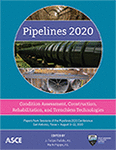Pipelines 2020
DC Water at Work: Mitigating Century Old Infrastructure from Historic Storms
Publication: Pipelines 2020
ABSTRACT
In 2018, an unprecedented series of drenching rain storms catapulted Washington, DC, to the wettest year on record since 1871. The extreme rainfall stemmed from a parade of storms which unleashed several severe flood events on the Washington area. Per National Weather Service, there were 1,391 flood-related reports in the Washington-Baltimore region during 2018. This compares to only 262 reports in 2017. On July 8, 2019, a new single rain event record was set, as over 3.3” of rain fell in a one (1) hour period along the Potomac River. This is the most torrential rain event on record, and it led to cars flooding along major commuter roads and even basement flooding at the White House. This repetitious creek and street flooding is pushing the endurance of the buried and surface water infrastructure, most built more than a century ago, to the limit. This presentation aims to highlight DC Water’s collaborative efforts among all stake holders within the local and federal levels, in expediting our engineered effort to mitigate the high-consequence failures caused by mother nature. The creek bed construction of a circa 1890 masonry sanitary sewer that, not on pier, saw its bottom fall out when the creek bed embankment was flooded and washed out. A sinkhole by the side of Eclipse outside the White House closed a busy commuter street, at 17th street NW, two blocks from Constitution Avenue. This “2019 White House Sinkhole” has its bullseye on top of DC Water’s buried regulator structure #29 with blind connection and masonry dam, circa 1878/1895. The back-to-back historic storm events also compromised a historic stone “log wall” retaining a robust road at the entrance of Georgetown Hospital, with buried 15-ft span brick culvert and 9-ft diameter inlet and outlet, by the side a federal wetland, all built in 1902. The high volume of runoff in the wetland during 2018 overpowered and collapsed the bulkhead beneath the retaining wall at the transition of 15-ft brick culvert to its upstream inlet with 9-ft diameter pipe. Before DC Water got NPS’ permit to implement a simple point repair, the record-breaking storm event on July 8, 2019, nearly washed out the entire bulkhead, sending a 15-ft long tree trunk through the torn bulkhead opening, resulting in a significantly larger and deeper washout at the foot of the retaining wall made of dry stack stone without any mortar. Upon engineering assessment and confirmation of the pull-away displacement in culvert brick wall, as well as the stacked stone retaining wall seated on the brick arch crown, DC Water went into expedited mitigation with in-house design and contracting to stabilize and protect this historic infrastructure.
Get full access to this article
View all available purchase options and get full access to this chapter.
Information & Authors
Information
Published In
Pipelines 2020
Pages: 179 - 190
Editors: J. Felipe Pulido, OBG, Part of Ramboll and Mark Poppe, Brown and Caldwell
ISBN (Online): 978-0-7844-8320-6
Copyright
© 2020 American Society of Civil Engineers.
History
Published online: Aug 6, 2020
Published in print: Aug 6, 2020
Authors
Metrics & Citations
Metrics
Citations
Download citation
If you have the appropriate software installed, you can download article citation data to the citation manager of your choice. Simply select your manager software from the list below and click Download.
